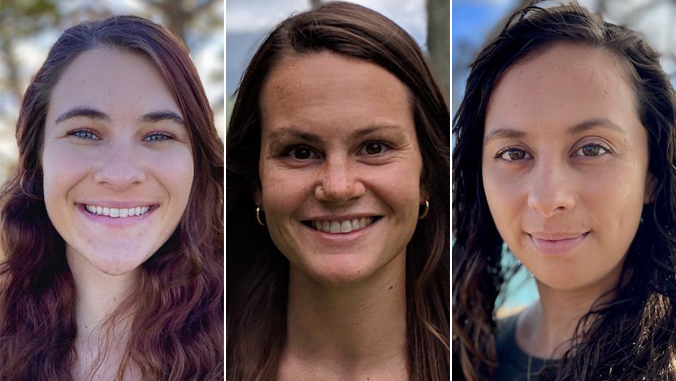
Three graduate students from the University of Hawaiʻi at Mānoa are spending one year focusing on critical marine policy issues in Washington, D.C. representing the UH Sea Grant College Program as John A. Knauss Marine Policy Fellows.
Gina Selig, Sarah Tucker and Emily Young were selected out of a highly competitive pool of applicants from across the nation to serve in either the legislative or executive branch of government.
“The Knauss Fellowship offers graduate students the invaluable opportunity to put their academic knowledge to practice in tackling marine, coastal and Great Lakes management and policy challenges at the federal level,” said Jonathan Pennock, National Sea Grant College Program director.
Gina Selig
Throughout Selig’s scientific career, she has sailed on multiple expeditions in the Pacific Ocean supporting deep-sea exploration and research as well as hydrographic surveying in remote parts of Southwest Alaska, which makes the opportunity to spend a year in the National Science Foundation’s (NSF) Office of Polar Programs (OPP) an extremely valuable learning experience.
“I’m truly honored and grateful for the opportunity to work in NSF’s Office of Polar Programs as the environmental policy fellow. I feel lucky to be placed in this unique position that has such an important role in protecting and preserving Antarctic wildlife and ecosystems,” said Selig. “The position not only aligns with my interests in the management of marine and terrestrial protected areas and assessment of environmental impacts, but also provides a once in a lifetime opportunity to experience this incredible ecosystem and witness the transformative work of OPP firsthand with a deployment in Antarctica.”
Sarah Tucker
Tucker’s interest in ocean science and conservation is motivated by her ability to share its curiosities and importance with others, which was a focus of her PhD work in marine biology examining the ecological and genomic diversity of the world’s most abundant organisms: the marine bacteria SAR11. She also investigated phytoplankton communities within and adjacent to the Heʻeia National Estuarine Research Reserve and their roles in water quality and food web dynamics.
“Working in the Arctic Research Program and communications at GOMO, the Global Ocean Monitoring and Observing Program at NOAA, aligns with my interests in ocean biogeochemistry and observations while expanding my knowledge of ocean policy and climate change impacts,” said Tucker. “Because the Arctic is warming much faster than the rest of the planet, and this poses many societal, scientific and policy challenges, there are lots of opportunities to explore new ideas and collaborations.”
Emily Young
Throughout her academic career, Young has been deeply involved in science communication, teaching and outreach activities, all of which have significantly shaped her career pathway towards the fellowship. Her role at the Bureau of Ocean Energy Management (BOEM), within the Department of the Interior, provides her with the opportunity to develop climate science expertise in the context of offshore and deep-sea habitats.
“One of the most valuable aspects of the Knauss fellowship is being granted the opportunity to dive into something new,” said Young. “My role as ‘climate science liaison fellow’ at BOEM allows me to build on my existing expertise in offshore, deep-sea habitats, while also developing new expertise in climate science. At the same time, I’m learning how the federal government operates, and witnessing firsthand how science is incorporated into decision-making.”
For more information, see Hawaiʻi Sea Grant’s website.
–By Cindy Knapman

